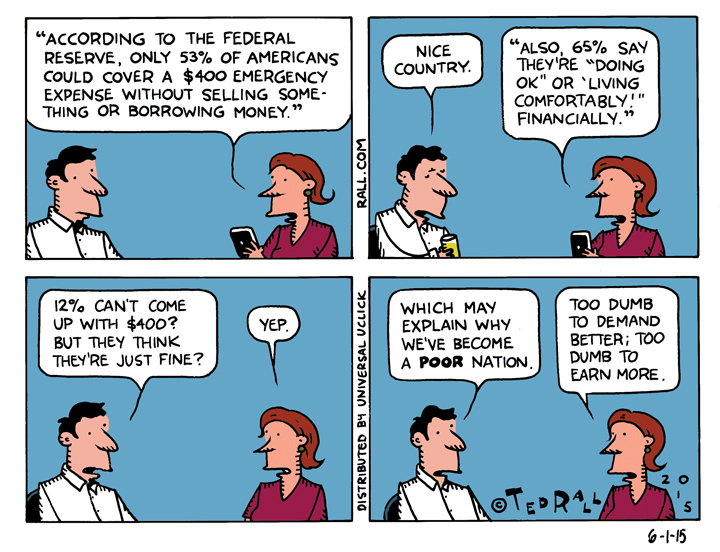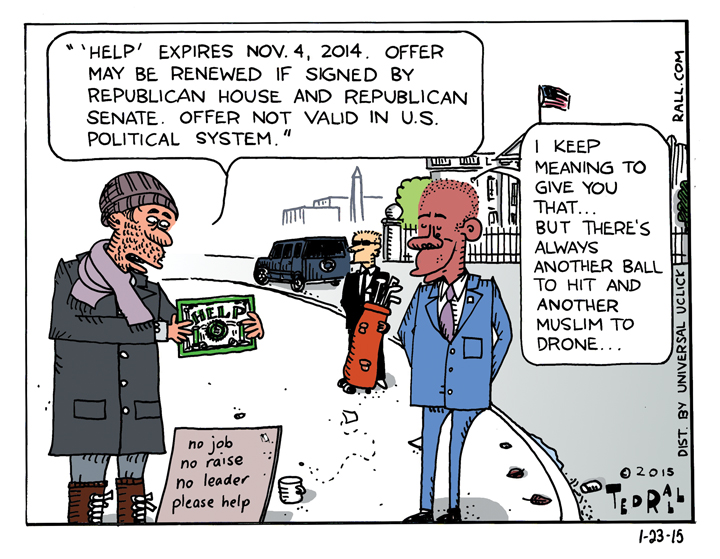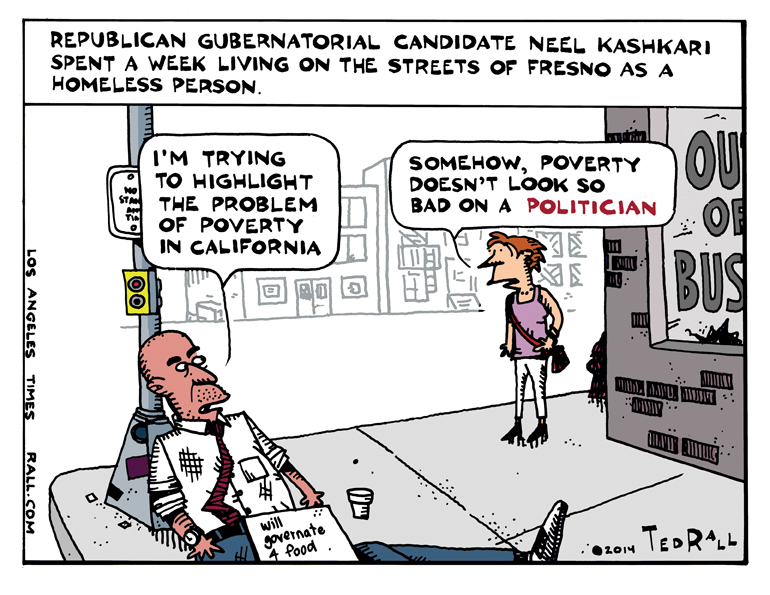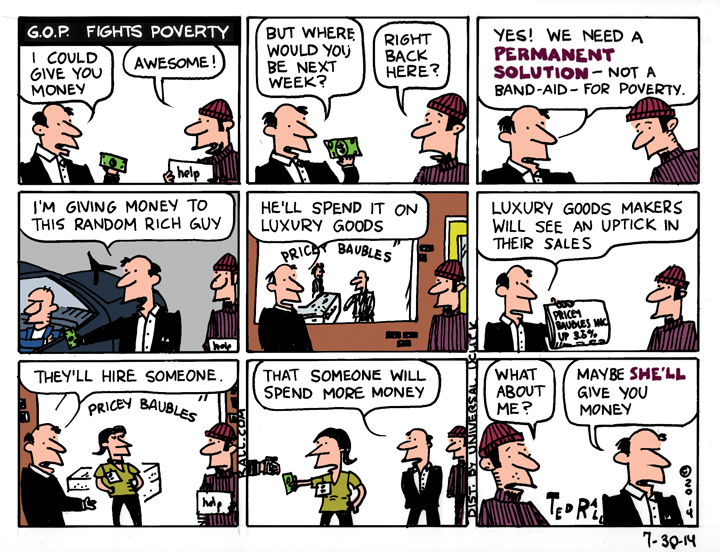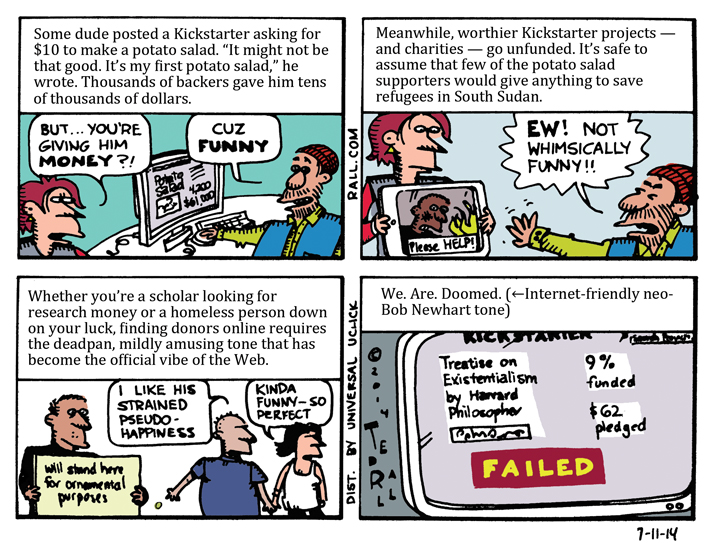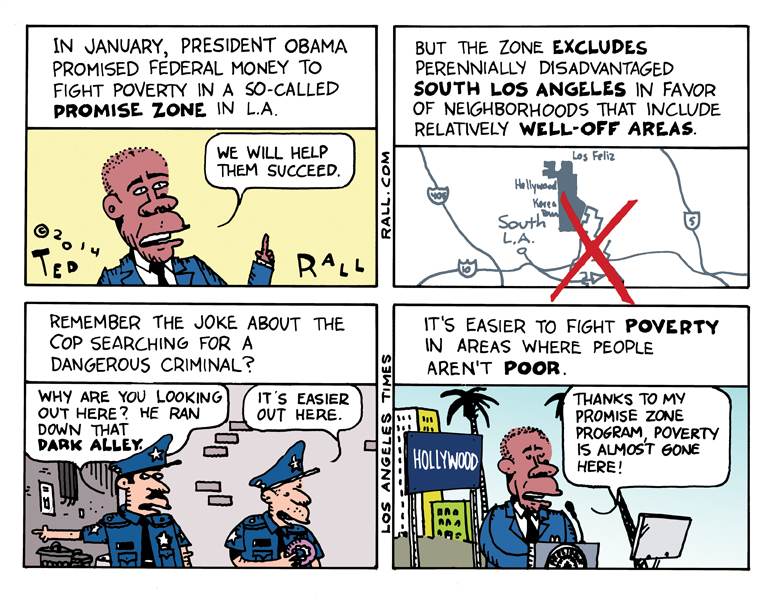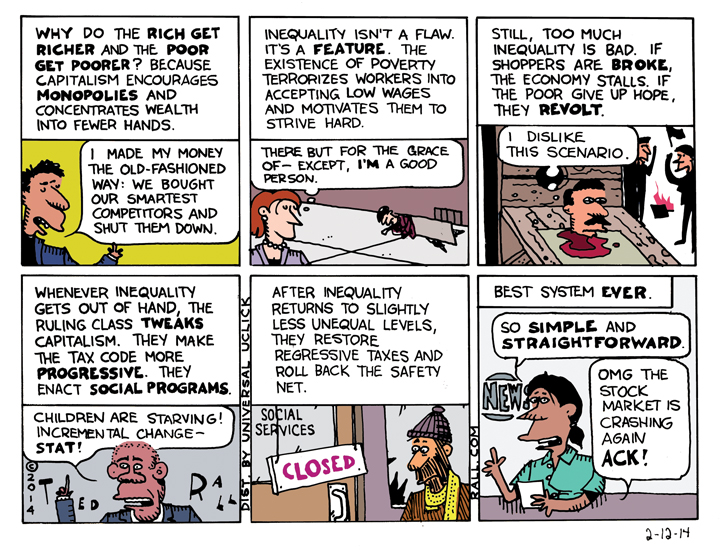53% of Americans can’t come up with $400 in a pinch. But 65% of Americans think they’re doing well financially. Who exactly are these 12% who don’t think being poor is, you know, being poor?
Offer Not Valid
Obama spent six years golfing, never lifting a finger to help those devastated by the 2008-09 economic collapse. Now that he’s an ultra-lame duck and has absolutely no way to get legislation through the Republican Congress (something he didn’t have in 2009), he’s pretending to “fight” for a higher minimum wage and better wages for American workers.
SYNDICATED COLUMN: Millions of Gen Xers Will Be Homeless Before You Know It

Forget terrorism, Ebola or even climate change — the most dangerous threat to this country is an epic retirement crisis.
We will soon see tens of millions of Americans reduced to poverty, bringing an end to the United States as an economic superpower.
Unlike attacks and pandemics, this crisis is an absolute certainty, one with a clear, near start date. But the media is hardly mentioning the imminent retirement crisis. So politicians haven’t even begun to think about it, much less take it seriously.
Actually, “retirement crisis” is a misnomer. The problem isn’t that people won’t be able to retire or will be living on a shoestring, though those things are true. We’re staring down the barrel of an epic old age crisis. For the average American, to be elderly will mean not mere belt-tightening, but real, grinding poverty: homelessness and hunger.
Throughout the last few decades, vulnerable people living from payday to payday have gotten battered by the shredding of the government safety net, a lack of accumulated savings caused by the boom-and-bust cycle of capitalism, and a lackluster real estate market.
Now members of the poor and lower middle class in their 50s and 60s are heading into a retirement crisis created by a perfect superstorm.
Traditional defined-benefit pension plans have been replaced by stingy 401(k)s and similar programs which employers no longer pay into, cap how much you can contribute (assuming you can afford it), take a beating during downturns in the stock market, and allow workers to tap when they’re laid off or run into financial trouble. After years of sketchy raids and outright theft, workers with old-fashioned corporate and government pensions can’t be sure their money will be there when they need it. The first Generation Xers — many of whom never had the opportunity to accumulate wealth due to several long recessions that impacted them particularly hard — will reach the traditional retirement age of 65 in the year 2024.
The facts are brutal:
No savings: The average Gen Xer only has a net worth of about $40,000 — enough to live on for a year. Maybe. In Akron. 36% of Americans don’t have a dime saved for retirement.
Later Social Security: Thanks to that lovable wacky Ronald Reagan, the Social Security retirement age was quietly raised to 67 for Gen Xers born after 1960. When you finally get Social Security, it doesn’t pay enough. The U.S. ranks third to last in social security benefits among developed nations.
Age discrimination: The continuing post-2008 recession hit those in their 50s especially hard; employers want cheaper, younger workers. 25% of Americans over age 55 now have no savings whatsoever.
About those pension plans: When journalists mention the retirement crisis, they focus on problems with the defined-benefit system. But that’s irrelevant to most Americans. 90% of private-sector workers don’t have one. Most government workers do — but 85% of Americans work in the private sector.
401ks suck (if you have one). Three out of four workers have no pension plan. What they might have is a 401k. The average Gen Xer who has a 401k — 69% don’t — has a $63,000 balance.
Financial experts say 92% of U.S. workers fall significantly short of what they’ll need to live decently after retirement. “In the decades to come,” Edward Siedle writes for Forbes, “we will witness millions of elderly Americans, the Baby Boomers and others, slipping into poverty. Too frail to work, too poor to retire will become the ‘new normal’ for many elderly Americans.”
This is about you — not some theoretical lazy Other.
“At some point,” Siedle says, “lack of savings, lack of employment possibilities and failing health will catch up with the overwhelming majority of the nation’s elders. Let me emphasize that we’re talking about the overwhelming majority, not a small percentage who arguably made bad decisions throughout their working lives.” [Emphasis is mine.]
America’s army of starving old people will drag down younger people too. “Public finances will be pushed to the limit, crowding out other priorities such as education,” Christian E. Weller predicts in The Hill. “Moreover, economic growth will be slower than it otherwise would be because employers will have more workers whose productivity is declining, while many older families, who could start successful new businesses, will forego those opportunities.”
And the pols?
Useless, Siedle concludes. “Conservatives are trying to pare back so-called entitlements that will mushroom in the near future and liberals have failed to acknowledge the crisis or propose any solutions.”
We can hit the streets to demand action now — or we’ll be living on them later.
(Ted Rall, syndicated writer and cartoonist, is the author of the new critically-acclaimed book “After We Kill You, We Will Welcome You Back As Honored Guests: Unembedded in Afghanistan.” Subscribe to Ted Rall at Beacon.)
COPYRIGHT 2014 TED RALL, DISTRIBUTED BY CREATORS.COM
SYNDICATED COLUMN: 50%+ of Americans Have Been Poor, and Capitalism Thinks That’s Awesome

Odds are, you are poor. Or you’ve been poor.
Conventional wisdom — i.e., what the media says, not what most people think — repeatedly implies that poverty is a permanent state that chronically afflicts a relatively small number of Americans, while the rest of us thrive in a vast, if besieged, middle class. In fact, most Americans between age 25 and 75 have spent at least one year living under the poverty line.
“One of the biggest myths about poverty in the United States is that a relatively small segment of the population is poor, and that this represents a more or less permanent underclass,” Columbia University economist and social work professor Irwin Garfinkel tells Columbia magazine. “But poverty is quite dynamic. Lots of people move in and out of poverty over the course of their lives. And it doesn’t take much for people at the edge to lose their footing: a reduction in work hours, an inability to find affordable day care, a family breakup, or an illness — any of these can be disastrous.”
Even if you bounce back, the effects of these financial setbacks linger. For young adults, attending cheaper colleges or passing up higher education — or being unable to afford to take a low-paid internship — burdens them with opportunity costs that hobble them the remainder of their lives (which will likelier end sooner). Debts accrue with compound interest and must be repaid; damaged credit ratings block qualified buyers from purchasing homes. Diseases go undetected and untreated during periods without healthcare. Gaps on resumes are a red flag for employers.
Americans pay a price for the boom-and-bust cycle of capitalism. To find out exactly how high the cost is, Professor Garfinkel and his colleagues at Columbia have created the Poverty Tracker, dubbed “one of the most richly detailed studies of poverty ever undertaken in the United States.” The Poverty Tracker is “a meticulous long-term survey of 2,300 New York households across all income levels…for at least two years” that aims “to create a much more intimate and precise portrait of economic distress than has ever been conducted in any US city.”
Initial findings were distressing: “While the city’s official poverty rate is 21%, the Columbia researchers found that 37% of New Yorkers, or about 3 million people, went through an extended period in 2012 when money was so tight that they lost their home, had their utilities shut off, neglected to seek medical treatment for an illness, went hungry, or experienced another ‘severe material hardship,’ as the researchers define such extreme consequences.”
Wait, it’s even worse than that:
“Even the 37% figure understates the number of New Yorkers who endured tough times in 2012. The researchers estimate that two million more endured what they call ‘moderate material hardship,’ which, as opposed to, say, losing one’s home or having the lights shut off, might involve merely falling behind on the rent or utility bills for a couple of months. Many others were in poor health. Indeed, the researchers found that if you add together all of those who were in poverty, suffered severe material hardship, or had a serious health problem, this represented more than half of all New Yorkers [emphasis is mine].”
The researchers hope that “they will have enough data to begin helping public authorities, legislators, foundations, nonprofits, philanthropists, and private charities address the underlying problems that affect the city’s poor” by the end of 2014.
Nationally, more than 35% of all Americans are currently ducking calls from collection agencies over unpaid debts.
What can be done?
Under this system? Not much. Democrats, who haven’t even proposed a major anti-poverty program since the 1960s, aren’t meaningfully better on poverty than Republicans.
As things stand, the best we can hope for from the political classes are crumbs: a few teeny-weeny proposals for wee reforms.
Like expanding day-care programs. More school lunches. Housing subsidies. “Additional investments in food programs.”
A drop in the bucket in an ocean of misery.
The Poverty Tracker shows that poverty is a huge problem in the United States. Unfortunately its authors, who draw their salaries from an institution intimately intertwined with monied elites, dare not openly suggest what they know to be true, that the key to eliminating poverty is to get rid of its root cause: capitalism.
(Ted Rall, syndicated writer and cartoonist, is the author of “After We Kill You, We Will Welcome You Back As Honored Guests: Unembedded in Afghanistan,” out Sept. 2. Subscribe to Ted Rall at Beacon.)
COPYRIGHT 2014 TED RALL, DISTRIBUTED BY CREATORS.COM
Neel Kashkari Takes to the Mean Streets of Fresno
Yes, Virginia, the Republicans are running someone against California governor Jerry Brown. His name is Neel Kashkari.
Kashkari has been virtually invisible throughout what has passed for the campaign. (Not literally. There is no evidence that he has mastered the ability to bend light around himself so as to render his physical form undetectable to the human eye. Just in the media, which has decided that he isn’t worth covering because he probably won’t win. Which is true, since the media won’t cover him. Funny how that works.)
What do you do when the struggle for visibility gets tough?
Publicity stunt!
In what his supporters would likely say was an earnest attempt to showcase the ongoing problem of un- and underemployment in California despite the economic “recovery” — if anyone bothered to ask his supporters — and what everyone else, including pundits, would call a cheap ploy, Kashkari says he spent the last week playacting as a homeless person in search of work.
Seema Mehta of the Times reports:
“Kashkari wrote that he took a Greyhound bus from Los Angeles to Fresno on July 21 with ‘only $40 in my pocket (and no credit cards), a backpack, a change of clothes and a toothbrush.’ He said he planned to find a job. “I am an able-bodied 41-year-old. Surely I could find some work. ‘Kashkari was accompanied by two videographers, who produced a 10-minute video. The footage shows a scruffy Kashkari saying, ‘This has been one of the hardest weeks of my life.'”
All Gen X smirkery aside, I think it’s admirable that any politician, especially a Republican — the difference between Democrats and Republicans is that Republicans don’t even pretend to care about poor people — is drawing attention to the misery experienced by millions of Californians suffering through grinding poverty with no foreseeable end in sight. Sure, Kashkari is a multi-millionaire who could, and did, go home whenever he wanted. But when’s the last time you slept outside to see what it was like? Hell, I don’t even like camping.
So, good on Kashkari.
Still, I have some logistical and logical questions for him.
Like, why Fresno? The economy isn’t that bad there, relatively.
Why forty bucks? Why not $20 or $100?
Did the $5 bus fare come out of the $40?
Did he panhandle? Steal? I would.
Why was a toothbrush deemed essential, but not floss? Was there even toothpaste, and if not, why not, and if so, why wasn’t it mentioned? How about mouthwash? (Note to Gov. Brown’s opposition research team: Kashkari’s commitment to oral hygiene halfhearted at best. 92% of voters say ‘ewww.’)
When the Man Who Would Be Governor approached foremen at Fresno area construction sites, how eager for work did he appear? After all, this was an experiment that would have failed mightily had his able-bodied 41-year-old self been scooped off the mean streets of the Raisin Capital and offered a zillion bucks to run a hedge fund. Did he, full of honesty and integrity, pledge to work hard at low wages with little concern for his personal safety? Or was he all Little Lord Fauntleroy about it: “I don’t do sweat, dude”?
So many questions. I’d ask them all, too. But that would be against the rules. He’s a long-shot gubernatorial candidate and I’m a pundit.
The GOP Finally Takes on Poverty
Republican Congressman and former vice presidential candidate Paul Ryan, infamous for budget proposals that denigrate and starve the downtrodden, has changed tack with an anti-poverty proposal that actually includes safety-net items like expanding the Earned Income Tax Credit. Still, the Republican Party remains in thrall to trickle-down economic theories that, if they worked, would take years to help poor people who need money now.
The Potato Salad Society
Some dude posted a Kickstarter asking for $10 to make a potato salad. “It might not be that good. It’s my first potato salad,” he wrote. Thousands of backers gave him tens of thousands of dollars. Meanwhile, worthier Kickstarter projects - and charities - go unfunded. Most of the potato salad supporters wouldn’t give anything to help refugees in South Sudan.
LOS ANGELES TIMES CARTOON: It’s Easier to Fight Poverty Where People Are Rich
The United States of America in Year 2014 is the wealthiest nation that has ever existed. Poverty among Americans is an obscenity: immoral, unnecessary, counterproductive. As disgusting as it is to watch $100,000 cars zoom past homeless panhandlers, however, there’s something even worse: politicians who pretend to care, who say they’re trying to help the poor and downtrodden, but are actually ignoring them as they revel in the institutional corruption of politics as usual.
As The Times’ Michael Finnegan, David Zahniser and Doug Smith reported:
In January, President Obama announced a block-by-block approach to relieving poverty in Los Angeles. Federal money, he said, would pour into a newly created Promise Zone.
The boundaries encompassed crowded immigrant communities around MacArthur Park and Koreatown, as well as upscale areas of Hollywood and Los Feliz. Left out was South L.A., where the poverty rate is higher. The exclusion stunned many South L.A. leaders.
Why did the White House snub South L.A., which is quantifiably poorer?
Only those previously funded organizations were eligible to seek Promise Zone aid. In Los Angeles, there was only one such group: a nonprofit led by Dixon Slingerland, a major campaign fundraiser for Obama and frequent White House visitor.
Under rules set by the White House and federal agencies, Mayor Eric Garcetti‘s office, working with Slingerland’s Youth Policy Institute, was required to draw the zone’s boundaries around an area where the nonprofit already was focusing its federal grants — either Hollywood or the northeast San Fernando Valley.
The result was an anti-poverty zone that left out communities south of the 10 Freeway, including areas of chronic poverty that drew worldwide attention after the 1965 and 1992 riots. Neighborhoods around Watts have a poverty rate 21% higher than communities within the Promise Zone, according to a Times analysis of U.S. Census Bureau data. Neighborhoods east of USC have a poverty rate 39% higher.
This appears to be a political manifestation of the phenomenon described in the important 1996 book “The Winner-Take-All Society.” Influence begets influence, wealth and power aggregate into increasingly fewer hands. It’s why, for example, the best-paid professional athletes get the biggest offers for lucrative product endorsement deals. The more famous you are, the more stuff you can sell. The more stuff you sell, the more famous you get.
“It just seems like those that have keep getting,” shot U.S. Rep. Janice Hahn, who represents South L.A., after the news broke that South L.A. had been excluded. “And those that never had don’t even have a chance.” Hahn “pointedly skipped” a White House ceremony where Obama announced L.A.’s Promise Zone.
City Councilman Bernard C. Parks, who represents part of South L.A., pointed to Dixon Slingerland’s influence with the president: “You know exactly why they came out first. It was preordained.”
Slingerman denies that the Promise Zone’s odd mapping had anything to do with political payback.
Perhaps not. But if Slingerback wanted favors from Obama, he was certainly in a position to ask. Finnegan et al noted: ” Since Obama took office, Slingerland has been to the White House 19 times, logs show. The visits included one to the residence for a reception, three to the West Wing and 10 to the Old Executive Office Building. He attended two receptions at Vice President Joe Biden‘s home at the U.S. Naval Observatory.” I don’t know about you, but I’m still waiting for my first invite.
The soft corruption of coziness, or coincidence? I know not. But it definitely looks bad.
And it doesn’t just look bad in Los Angeles. The other four PZs are drawing fire too.
According to The Philadelphia Inquirer, “several areas of the city face challenges similar to or worse than Mantua,” the West Philly neighborhood designated as that city’s Promise Zone.
Politics appears to have influenced the selection of at least three of the first five Promise Zones. “Rural Kentucky, of all the distressed rural districts and deserving areas across the country, seems a somewhat random choice, but Kentucky Senators Rand Paul and Mitch McConnell both attended the [Promise Zone] announcement, perhaps boosting the chances of bipartisan support,” wrote Susan Greenbaum.
But hey, maybe residents of South L.A. should be relieved that the Obama Administration gave them the cold shoulder. If the Promise Zones work as advertised, planning experts say, they’ll spur gentrification, rising rents and — ultimately — evictions.
And as always, the rich get richer and the poor get ignored.
How Capitalism Deals with Inequality
President Obama and the Democrats have finally decided, five years after his election, to begin talking about the issue of income inequality, which has been increasing since the early 1970s. But their rhetoric makes it sound like inequality is a weird byproduct of capitalism when, in fact, it is a key feature of an economic system that relies on poverty and exploitation. This is the best system ever conceived?

